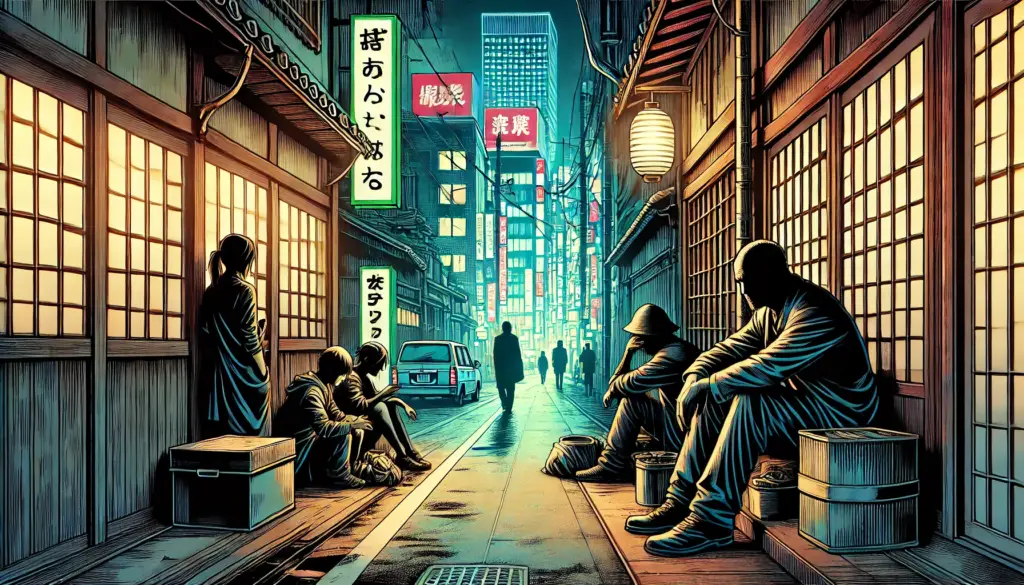
Introduction
Japan is often praised for its clean streets and safe neighborhoods. To many visitors, it may seem like there are no homeless people at all. Yet, hidden from the eyes of tourists and even many locals, entire communities of homeless individuals exist in Japan. They live in places most people never visit, forming their own networks of survival. This article explores where they live, why these “hidden streets” remain invisible, and why many homeless individuals do not—or cannot—receive welfare support.
1. Hidden Habitats: Where Japan’s Homeless Live
Homelessness in Japan is not usually found in the same visible ways as in some Western countries. Instead of sleeping in the middle of busy streets, many homeless individuals gather in quieter corners of large cities.
In Tokyo, areas such as Sanya and parts of Shinjuku have long been associated with day laborers and men who later became homeless. Parks, riversides, and the spaces under elevated highways or train tracks often become living areas. Blue tarpaulin tents, cardboard shelters, and makeshift huts can sometimes be seen in these locations.
Osaka has its own distinctive homeless districts, such as Kamagasaki (sometimes referred to as Airin). Here, people form tightly knit groups, creating informal marketplaces or social zones where they support one another. To outsiders, these areas may look chaotic, but they function as small communities, providing a sense of belonging to those who have lost ties with family or mainstream society.
These “invisible towns” rarely appear on tourist maps, and most visitors never realize they exist. Still, they represent a crucial part of Japan’s urban landscape.
2. Why Many Homeless People Don’t Receive Welfare
Japan has a welfare system, known as seikatsu hogo, which provides financial assistance, housing support, and medical care. In theory, anyone without sufficient means to live should qualify. In reality, however, many homeless people do not apply for welfare—or if they do, they are often discouraged or rejected.
2.1 Bureaucratic Barriers
One major obstacle is the application process. Many welfare offices are known to turn away applicants at the door, claiming they lack a fixed address or are still “capable of working.” Officially, homelessness should not disqualify someone from welfare, but in practice, frontline staff sometimes make it difficult to apply.
2.2 Social Stigma and Pride
For many homeless individuals, applying for welfare feels like losing dignity. There is a strong cultural stigma in Japan against relying on public assistance. Some prefer to endure life on the streets rather than face what they see as shameful dependence. Especially among older men, there is a sense of pride in surviving without state support, even under harsh conditions.
2.3 Distrust and Negative Experiences
Stories circulate about welfare recipients being placed in poor-quality hostels or losing much of their allowance to hidden fees. Others recount experiences of being treated coldly or judged by welfare office staff. Over time, distrust builds, and many choose to avoid the system altogether.
2.4 Lack of Information and Access
Another issue is simple awareness. Many homeless people are not fully informed about their rights. Without a phone, address, or internet access, navigating the welfare system is extremely difficult. Even when services exist, they often go unused because the people who need them most cannot reach them.
3. Invisible Communities and Their Social Role
Although their living conditions are harsh, homeless communities often create support systems of their own. In places like Kamagasaki in Osaka, some individuals run small stalls, trade goods, or form local “third places”—shared spaces outside of home or work that allow for connection and companionship.
These networks provide more than survival; they offer dignity and belonging. For many who feel rejected by society, these communities become their true home. Ignoring them or dismantling their shelters without offering alternatives only deepens the problem.
4. Rethinking Welfare and Support
To improve the situation, Japan must bridge the gap between homeless communities and welfare services. Several approaches could make a difference:
- Simplifying the process: Making welfare applications easier and less intimidating would lower barriers.
- Trauma-informed care: Welfare staff should treat applicants with dignity and respect, avoiding judgmental attitudes.
- Outreach programs: Instead of expecting homeless individuals to come to government offices, mobile teams could meet them where they live.
- Empowering solutions: Support programs should preserve autonomy, giving people control over their lives rather than placing them into rigid systems.
Interestingly, when homeless individuals apply for welfare with the help of advocates or support groups, the approval rate is nearly guaranteed. This shows that the problem is not the law itself, but the gap between rights on paper and their enforcement in practice.
Conclusion
Japan’s homeless population is not always visible, but it is there—living in riverside tents, under bridges, and in overlooked districts of Tokyo and Osaka. Tourists may never notice them, but these communities represent a hidden layer of Japanese society.
Welfare systems exist, but many barriers—bureaucratic, psychological, and social—prevent people from accessing them. Until those barriers are addressed, Japan’s homeless will continue to live on the margins, surviving in the “invisible towns” that most people never see.
Addressing homelessness in Japan requires more than money—it requires compassion, dignity, and policies that meet people where they are. Only then can the unseen become visible, and the forgotten be remembered. 🌱



















































